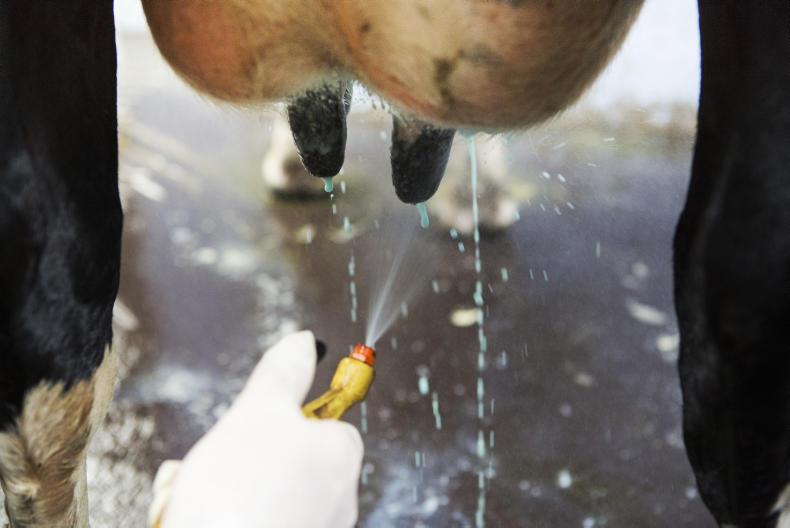The plan of action to tackle mastitis management should revolve around three key management factors:
(a) CMT test (paddle) every freshly calved cow/heifer before milk from her goes to the bulk tank. (b) Start milk recording in March. (c) Increase the frequency of milk recording to once per month instead of every eight weeks. In early lactation some heifers will not pass the CMT test after calving. Often, first-calvers can be stressed for one reason or another after calving and this can display itself in a high cell count (SCC) figure without obvious signs of clinical mastitis (ie no clots in the milk).
The best policy with these heifers that calve down and fail the CMT (paddle test) is to keep milk from the bulk tank and treat the infected quarter with antibiotic tubes. Cure rate should be good if treated in time. Once they pass the CMT, the milk goes to the bulk tank.
Best results
The best results with tubes are achieved by treating young cows or freshly calved heifers. Poor success rates have been measured with mature cows that have a history of infection. Depending on stage of lactation, the best protocol with those ladies is probably to dry off the infected quarter. That is hard to do in early lactation but maybe you can manage her for a few weeks depending on the type of mastitis.
Overmilking
If you are a long time milking on your own, there is a chance you could be overmilking some cows. This will do nothing for your SCC and herd health. Maybe consider milking through a smaller number of units and leave some units hanging up if you are on your own.
The other real option is to keep a separate herd right through the year or as long as required
You will be longer in the parlour but the job will be done better if you are more comfortable with that.
Another option
Another option is to keep a separate herd right through the year or as long as required – this also helps staff give the time required to cows that need treatment. The real benefit with a second herd is that the chance of cross-infection is much less when milked after the main herd.
While farm staff often complain managing a second herd might be a right pain, the pain is small relative to the alternative. Compared with leaving infected cows in the main herd and allowing the rest of your herd become infected and costing the business a lot of money, the pain could be described more like a twisted ankle than a broken leg.
Read more
Battle to keep lid on vet bills
The plan of action to tackle mastitis management should revolve around three key management factors:
(a) CMT test (paddle) every freshly calved cow/heifer before milk from her goes to the bulk tank. (b) Start milk recording in March. (c) Increase the frequency of milk recording to once per month instead of every eight weeks. In early lactation some heifers will not pass the CMT test after calving. Often, first-calvers can be stressed for one reason or another after calving and this can display itself in a high cell count (SCC) figure without obvious signs of clinical mastitis (ie no clots in the milk).
The best policy with these heifers that calve down and fail the CMT (paddle test) is to keep milk from the bulk tank and treat the infected quarter with antibiotic tubes. Cure rate should be good if treated in time. Once they pass the CMT, the milk goes to the bulk tank.
Best results
The best results with tubes are achieved by treating young cows or freshly calved heifers. Poor success rates have been measured with mature cows that have a history of infection. Depending on stage of lactation, the best protocol with those ladies is probably to dry off the infected quarter. That is hard to do in early lactation but maybe you can manage her for a few weeks depending on the type of mastitis.
Overmilking
If you are a long time milking on your own, there is a chance you could be overmilking some cows. This will do nothing for your SCC and herd health. Maybe consider milking through a smaller number of units and leave some units hanging up if you are on your own.
The other real option is to keep a separate herd right through the year or as long as required
You will be longer in the parlour but the job will be done better if you are more comfortable with that.
Another option
Another option is to keep a separate herd right through the year or as long as required – this also helps staff give the time required to cows that need treatment. The real benefit with a second herd is that the chance of cross-infection is much less when milked after the main herd.
While farm staff often complain managing a second herd might be a right pain, the pain is small relative to the alternative. Compared with leaving infected cows in the main herd and allowing the rest of your herd become infected and costing the business a lot of money, the pain could be described more like a twisted ankle than a broken leg.
Read more
Battle to keep lid on vet bills






 This is a subscriber-only article
This is a subscriber-only article










SHARING OPTIONS: